The rise of the novel narrative, as perfected by Ian Watt in 1957, and extended by many other literary histories in the years since, is not "wrong," but it is biased and incomplete. Why is this so? First of all, Watt's classic account places the novel within a progressive narrative, which assumes that the modern era has discovered increasingly powerful writing technologies for representing reality: he calls this "formal realism" and links it to another focus of modernist triumphant narratives: the bourgeois invention of a complex and deep self. Secondly, the rise of the novel narrative is vitiated by the fact that its essential aim is to legitimize the novel as a form of literature. Thus the rise of the novel narrative demonstrates that the technology of realism enabled prose narratives about love and adventure, which large numbers of readers had begun to read for entertainment by the second half of the 17th century, to rise into a form of literature every bit as valuable and important as the established literary types of poetry, epic and drama. Thirdly, and this follows from the first two, the use of the definite article in the phrase "rise of the novel" turns novelness into a fugitive essence every particular novel strives to realize. What has been the effect of this narrative? It has ratified the project of the novel's moral and aesthetic elevation undertaken by novelists from Richardson, Fielding, Prevost and Rousseau to Flaubert, (Henry) James, Joyce and Woolf. But it has also impoverished our sense of what the novel is, first by taking novel criticism into interminable and tendentious debates about what realism really is, and second by making it our business to be guardians of the boundary between the "truly" novelistic and the "merely" fictional. We need a more historically rigorous and culturally inclusive conception of what the novel is and has been. My recent book, Licensing Entertainment aims to contribute to such a project. There, I document the development of the rise of the novel narrative within a long literary historical tradition that begins with Clara Reeve (1785) and John Dunlop (1814) and extends through many of the literary histories before Watt (including Scott, Hazlitt, Taine, Saintsbury, ). At the same time I have articulated my critical differences from Watt and many more recent critics who have sought to update or revise that narrative. (Licensing Entertainment, 1-44)
To develop a more inclusive understanding of early modern novel reading and to grasp novels at their highest level of generality, it is useful to compare the novel to that other successful offspring of the cultures of print, the newspaper. A newspaper is not just an unbound folio sheet printed with ads and news. It evolved within a social practice of reading, drinking (usually coffee or tea) and conversation; it required the development of the idea of "the world" as a plenum of more or less remote, more or less strange things--events, disasters, commodities--translated into print and worthy of our daily attention. The idea of the modern may be the effect of this media-assisted mutation in our way of taking in the world. This intricate marriage of print form and social practice has survived to this day as "reading the paper." In an analogous fashion the institution of novel reading requires a distinct mutation of both print forms and reading practices. While the printing of books devoted to prestigious cultural activities (like religion, law, natural philosophy) began in the 15th century and gained momentum in the 16th century, it was not until the later 17th century that short novels helped to shift the practices of reading so that novels could become a mode of entertainment. Several factors helped promote novel reading for entertainment: lower printing costs; an infrastructure of booksellers, printers and means of transport; a critical mass of readers of vernacular writing; and the opportunistic exploitation of the new vogue for reading novels (usually in octavo or duodecimo format) by generations of printers and booksellers. But if there was to be a rise of novel reading, it required a complex shift in reading practices. Historians of reading like Robert Darnton and Roger Chartier have described these changes, changes which are never complete or unidirectional: from intensive reading of a few books (like the Bible) to extensive reading of a series of similar books (like novels); from slow reading as a prod to meditation to an absorptive reading for plot; from reading aloud in groups to reading alone and in silence; from reading the Bible or conduct books as a way of consolidating dominant cultural authority to reading novels as a way to link kindred spirits; from reading what is good for you to reading what you like. Like television watching in the mid 20th century, novel reading took France and England by storm; like television watching, reading novels engendered excitement and resistance in the societies where it first flourished.
In this essay I will interpret some of the paintings and prints of the period that stage readers reading in hopes of broadening our understanding of the first century of novel reading. In adopting this strategy, I will be doing the reverse of what early modern image makers have done. As we shall see, early modern artists use images of readers reading to reflect upon the nature of viewing painting; in this essay, I will read these paintings to see how they reflect the crisis in early modern reading provoked by the popularity of reading novels for entertainment. Anyone surveying the Dutch and French genre paintings and prints of the 17th and 18th century--a type of image making that captures ordinary people in their everyday domestic activities--will quickly discover the currency of images of readers reading. From old men reading grand folios in solitude to young women absorbed in their novels, the paintings and prints of the period stage reading as inviting, compelling, and sometimes dangerous. They document the period's fascination with what was after all still a relatively new activity, one which, with the spread of literacy, was becoming an increasingly important part of everyday life. These images don't merely reflect a struggle around literacy happening elsewhere; instead, these images are themselves part of a critical debate that developed, over the course of the early modern period, as to how reading influences readers. What started as a promotional campaign for the reading of moral and didactic books ends up as a culture war about the pleasures and dangers of novel reading. However these visual texts also meditate upon a cultural problem closely related to book reading, the question of how a viewer should benefit from their encounter with a painting.
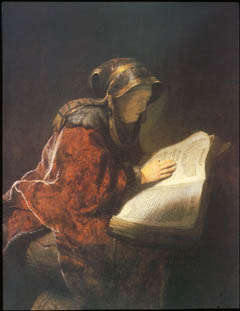 I
begin with several images that communicate the higher purposes of reading.
Rembrandt’s "The Prophetess Anne" (figure 1: 1631) suggests
the thoughtful solitude of a reader absorbed in her book. Several features
of this painting's composition imbue reading with hushed reverence: the
old woman bends into the grand folio volume she holds; the hand with which
she gently touches the page is painted in high focus; a swirl of color
and light--hood, shawl and page--cast her face into the shade of meditation;
there is an utter absence of distracting background. This painting, in
which Rembrandt used his mother as a model, stages reading as an intimate
and delicious encounter with the light of truth. In a painting by Chardin
from 1734 (figure 2), reading is imbued with a similar hush and solemnity.
However, the different titles given to this celebrated painting suggest
the pivotal role of reading in the professions: "The Chemist in his
laboratory", "The Alchemist", "A Philosopher occupied
with his Reading" (1734; the Salon of 1753), and more recently,
I
begin with several images that communicate the higher purposes of reading.
Rembrandt’s "The Prophetess Anne" (figure 1: 1631) suggests
the thoughtful solitude of a reader absorbed in her book. Several features
of this painting's composition imbue reading with hushed reverence: the
old woman bends into the grand folio volume she holds; the hand with which
she gently touches the page is painted in high focus; a swirl of color
and light--hood, shawl and page--cast her face into the shade of meditation;
there is an utter absence of distracting background. This painting, in
which Rembrandt used his mother as a model, stages reading as an intimate
and delicious encounter with the light of truth. In a painting by Chardin
from 1734 (figure 2), reading is imbued with a similar hush and solemnity.
However, the different titles given to this celebrated painting suggest
the pivotal role of reading in the professions: "The Chemist in his
laboratory", "The Alchemist", "A Philosopher occupied
with his Reading" (1734; the Salon of 1753), and more recently, 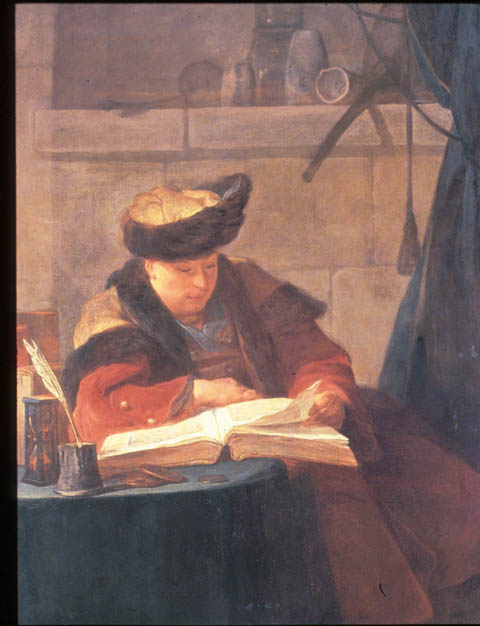 "Portrait
of the Painter Joseph Aved." This painting's communication of the
cultural centrality of reading is made explicit in the contemporary commentary
upon this image by the Abbe Laugier at the Salon of 1753: "This is
a truly philosophical reader who is not content merely to read, but who
meditates and ponders, and who appears so deeply absorbed in his meditation
that is seems one would have a hard time distracting him."(Fried,
11) In Absorption and Theatricality, a broad spectrum of French
18th century genre painting, Michael Fried demonstrates what he calls
"the primacy of absorption," in the subjects , who are represented
reading, sleeping, playing games, or caught up in a moment of high personal
drama. Fried shows how representation of figures deeply absorbed in some
activity becomes a strategy for taking painting beyond the arch theatricality
and superficial sensuality attributed to the Rococo style by mid century.
At the same time various compositional effects are used to produce paintings
that will absorb the beholder of the painting: rich painterly surfaces
(Chardin), animated brush work (Fragonard), and didactic drama (Greuze).
It is no surprise, I think, that figures of readers reading figure so
prominently in this elevation of the cultural role of genre painting:
by articulating beholding an image with reading a book, images of reading
could anchor the greater cultural significance being claimed for painting.
It is as though these images are saying, "look at this image with
the same seriousness of purpose that these readers accord to reading."
"Portrait
of the Painter Joseph Aved." This painting's communication of the
cultural centrality of reading is made explicit in the contemporary commentary
upon this image by the Abbe Laugier at the Salon of 1753: "This is
a truly philosophical reader who is not content merely to read, but who
meditates and ponders, and who appears so deeply absorbed in his meditation
that is seems one would have a hard time distracting him."(Fried,
11) In Absorption and Theatricality, a broad spectrum of French
18th century genre painting, Michael Fried demonstrates what he calls
"the primacy of absorption," in the subjects , who are represented
reading, sleeping, playing games, or caught up in a moment of high personal
drama. Fried shows how representation of figures deeply absorbed in some
activity becomes a strategy for taking painting beyond the arch theatricality
and superficial sensuality attributed to the Rococo style by mid century.
At the same time various compositional effects are used to produce paintings
that will absorb the beholder of the painting: rich painterly surfaces
(Chardin), animated brush work (Fragonard), and didactic drama (Greuze).
It is no surprise, I think, that figures of readers reading figure so
prominently in this elevation of the cultural role of genre painting:
by articulating beholding an image with reading a book, images of reading
could anchor the greater cultural significance being claimed for painting.
It is as though these images are saying, "look at this image with
the same seriousness of purpose that these readers accord to reading."
In the 18th century, reading was not always silent and solitary;
it was also oral and collective. Reading could offer a means of inculcating
religious and family values. In this painting 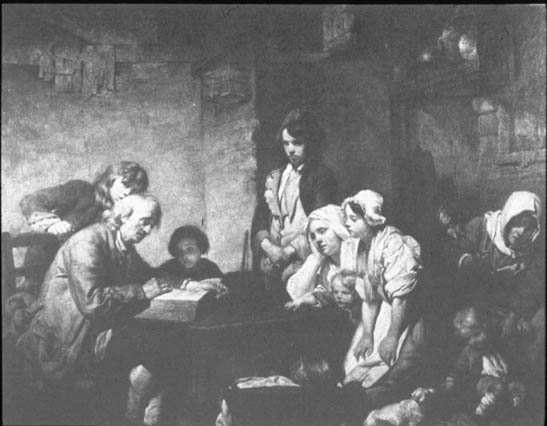 by
Greuze, entitled "The Father of the Family reads the Bible to his
children", (figure 3; Salon 1755) reading has the power to compose
a magic circle in which nearly the whole family is absorbed into the power
of Scripture as it is relayed through the father's voice. Like the paintings
of Rembrandt and Chardin, this painting grasps a particular moment: when
the smallest child's effort to play with a dog fails to distract a family
utterly absorbed by the reading. In this way the power of reading to move
its auditors is put on visual display. How does this painting earn its
claim to broad moral significance? Norman Bryson argues that Greuze's
dramatic tableaus of family life arrange a variety of ages and human types
out of a single family, so that, hermetically sealed off from the world
outside the home, a general "idea of 'humanity' with its powerful
emotional and didactic charge, can be generated."(Bryson, 128)
by
Greuze, entitled "The Father of the Family reads the Bible to his
children", (figure 3; Salon 1755) reading has the power to compose
a magic circle in which nearly the whole family is absorbed into the power
of Scripture as it is relayed through the father's voice. Like the paintings
of Rembrandt and Chardin, this painting grasps a particular moment: when
the smallest child's effort to play with a dog fails to distract a family
utterly absorbed by the reading. In this way the power of reading to move
its auditors is put on visual display. How does this painting earn its
claim to broad moral significance? Norman Bryson argues that Greuze's
dramatic tableaus of family life arrange a variety of ages and human types
out of a single family, so that, hermetically sealed off from the world
outside the home, a general "idea of 'humanity' with its powerful
emotional and didactic charge, can be generated."(Bryson, 128)
In all three of these paintings—whether reading is oral or silent, part
of solitude or social exchange—it is supposed that one reads to improve
the self. In The Practices of Everyday Life, Michel DeCerteau suggests
that a particular concept of the book lies at the heart of the enlightenment
educational project: "The ideology of the Enlightenment claimed that
the book was capable of reforming society, that educational popularization
could transform manners and customs, that an elite's products could, if
they were sufficiently widespread, remodel a whole nation."(166)
This enlightenment project is, according to De Certeau, structured around
a certain concept of education as mimicry, with a "scriptural system"
that assumes that "although the public is more or less resistant,
it is molded by (verbal or iconic) writing, that it becomes similar to
what it receives, and that it is imprinted by and like the text which
is imposed on it."(167) The disciplinary promise and weight of
the book receives their most explicit expression in early modern education.
Here are several images that express different aspects of that vast cultural
project. In a painting by Reynolds, entitled a "Boy Reading"(figure
4; 1747),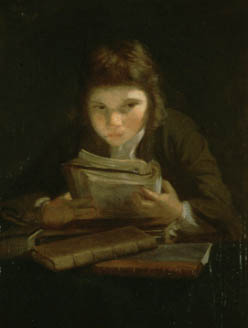 the tension between resolute body language and an abstracted gaze communicates
the arduous demands of labor with books. To imprint the knowledge of the
book upon one’s mind requires all of one’s energy, as expressed for example,
in Greuze’s "A Student who studies his Lesson" (figure 5; 1757),
the tension between resolute body language and an abstracted gaze communicates
the arduous demands of labor with books. To imprint the knowledge of the
book upon one’s mind requires all of one’s energy, as expressed for example,
in Greuze’s "A Student who studies his Lesson" (figure 5; 1757),
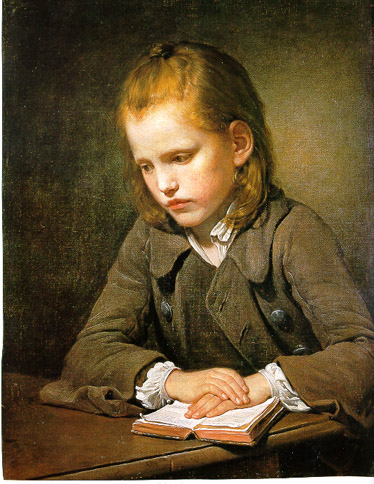 where
the posture of the student--he is poised over the book--and the high focus
of the fingers crossed over the volume--suggest the concentration required
to memorize. This student, like Rembrandt's Prophetess, and like Chardin's
philosopher, is touched into a state of silent thought by the book he
touches. In the companion piece of the same child, we can see the exhaustion
this sort of intensive reading may entail. ( Greuze, "A Child Who
Sleeps on his Book" (figure 6; 1755))
where
the posture of the student--he is poised over the book--and the high focus
of the fingers crossed over the volume--suggest the concentration required
to memorize. This student, like Rembrandt's Prophetess, and like Chardin's
philosopher, is touched into a state of silent thought by the book he
touches. In the companion piece of the same child, we can see the exhaustion
this sort of intensive reading may entail. ( Greuze, "A Child Who
Sleeps on his Book" (figure 6; 1755))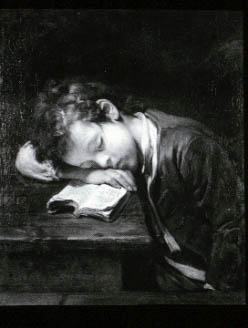
Finally, in a painting by Chardin, "A young girl reciting her Gospels,"
(figure 7;1753), 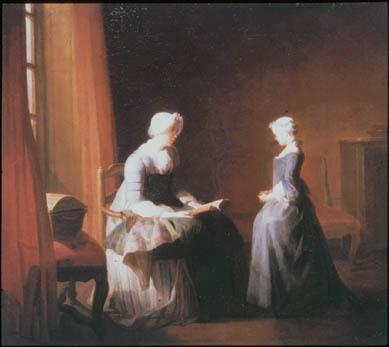 one
grasps the expected payoff of the enlightenment pedagogical project: a
young girl stands before her mother, who is holding a book, and recites
what she has learned from her reading. The intimacy of this domestic space
does not qualify the solemn importance of what is transpiring. Here truth
is given its ideal symbolic resonance as light: it passes from Nature
(as sunlight) to the mother ('s dress) to the gospels she holds, to the
face and bonnet of the young girl who recites the Word she has learned.
While this metaphorical substitution of light for truth has its grounds
in the fourth Gospel (John 1:4-5,9), this trope was also of course adapted
by secular thinkers of the Eighteenth century to characterize this epoch
as an "age of Enlightenment."(Kant) These four paintings describe,
celebrate, and promote the proper practice of reading as a way to enlighten
readers by educating them. Of course, like all representations of reading
or spectatorship, these images don’t really tell us what is going on when
one reads. But notice the implicit corollary of the enlightenment program
of reading as mimicry: by making the reader a passive receptacle for
the book’s meaning, this theory of reading makes the reading of the wrong
kind of writing especially dangerous. By interpreting reading as automatic
and uncritical, the enlightenment theory of reading produced as its logical
correllary the anxiety triggered by the popularity of novels among the
young.
one
grasps the expected payoff of the enlightenment pedagogical project: a
young girl stands before her mother, who is holding a book, and recites
what she has learned from her reading. The intimacy of this domestic space
does not qualify the solemn importance of what is transpiring. Here truth
is given its ideal symbolic resonance as light: it passes from Nature
(as sunlight) to the mother ('s dress) to the gospels she holds, to the
face and bonnet of the young girl who recites the Word she has learned.
While this metaphorical substitution of light for truth has its grounds
in the fourth Gospel (John 1:4-5,9), this trope was also of course adapted
by secular thinkers of the Eighteenth century to characterize this epoch
as an "age of Enlightenment."(Kant) These four paintings describe,
celebrate, and promote the proper practice of reading as a way to enlighten
readers by educating them. Of course, like all representations of reading
or spectatorship, these images don’t really tell us what is going on when
one reads. But notice the implicit corollary of the enlightenment program
of reading as mimicry: by making the reader a passive receptacle for
the book’s meaning, this theory of reading makes the reading of the wrong
kind of writing especially dangerous. By interpreting reading as automatic
and uncritical, the enlightenment theory of reading produced as its logical
correllary the anxiety triggered by the popularity of novels among the
young.
Given the enormous cultural investment in reading for instruction, how did reading for entertainment become an important new form of reading? The market plays a pivotal role in advancing this new kind of reading. In the England of the early 18th century, printed matter became what it is today: a commodity on the market. Rather than requiring subsidy by patrons, print received its ultimate support from that complex collaboration between producers and consumers we call "the market." Eighteenth century observers of these changes were less sanguine and less resigned about the effects of taking culture to the market than we seem to be today. In The Fable of the Bees (1712, 1714) Bernard Mandeville offers an ironic celebration of the surprising effects of markets: many individual decisions produce effects in excess of any single guiding intention. But while the market in books meant increases in both production and wealth, it also entailed the publication of anything that might sell, a relaxation of "standards" and an unprecedented access to print for writers of all levels of quality, in both 18th century senses of that word—value and class. Since the 18th century this new cultural formation—then dubbed "Grub Street", now called "Hollywood"—has been celebrated and condemned for its fecundity and filth, its compelling vulgarity. To conservative critics of the 18th century print market, the trade in books seemed a system dangerously out of control precisely because no one was in control.
Improvements in the production and distribution of printed books allowed
booksellers to expand the numbers, kinds and formats of books printed;
this allowed booksellers to promote reading for entertainment. However,
reading for entertainment set off a debate about the proper functions
of reading. Although publishers found that many species of books (from
ghost stories to travel narratives to a criminal’s Newgate confessions)
might gratify this desire for reading pleasure, no genre was more broadly
popular than novels. We can glimpse one way novels were used in this painting
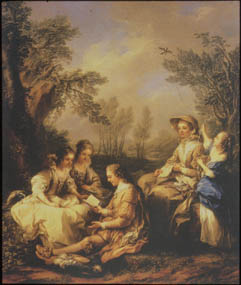 by
Carle Van Loo, entitled "the Spanish Reading" (figure 8; 1754).
In this idealized bucolic setting, reading aloud harmonizes a diverse
group into a tableau of "the good life." Here a young beau reads
to two young women, who appear entirely enraptured by what he reads. An
18th century commentator interprets the painting in terms of
the anti-novel discourse which developed to oppose novel reading.
by
Carle Van Loo, entitled "the Spanish Reading" (figure 8; 1754).
In this idealized bucolic setting, reading aloud harmonizes a diverse
group into a tableau of "the good life." Here a young beau reads
to two young women, who appear entirely enraptured by what he reads. An
18th century commentator interprets the painting in terms of
the anti-novel discourse which developed to oppose novel reading.
"A young man dressed in Spanish costume is reading aloud from a small book which, on the evidence of his keen attention and that of the company, can be recognized as a novel dealing with love. Two young girls listen to him with a pleasure expressed by everything about them. Their mother (actually their governess), who is on the other side of the reader and behind him, suspends her needlework in order to listen also. But her attention is altogether different from that of the girls; one reads in it the thoughts that she is having, and the mixture of pleasure given to her by the book and the fear she perhaps entertains of the dangerous impression that that book might make on young girl’s hearts." [Quoted by Fried, 27]
Print might impress itself upon the (page of an) impressionable heart: this metaphor, which uses the mechanism of printing (the press which makes identical impressions) to elucidate the practice of reading, resonates through Eighteenth century discussions of print media policy. Worry focuses upon a possible reversal of proper agency, by which a weakened subject—the susceptible reader—might come under the control of a smart object—the insinuating novel. Thus "The Whole Duty of Woman" (of 1737) registers this warning to novel readers: "Those amorous Passions, which it is [the novel’s] Design to paint to the utmost Life, are apt to insinuate themselves into their unwary Readers, and by an unhappy Inversion a Copy shall produce an Original." In keeping with the latent misogyny of the period’s anti-novel discourse, it was widely thought that novel reading could induce a restructuring of the labile emotions of the woman reader.
If collective reading of a novel carried risks, what might be the effect
of novel reading upon a solitary woman reader? We can approach this question
by looking at what two major French painters of the mid 18th century do
with the topic of the woman alone with her novel.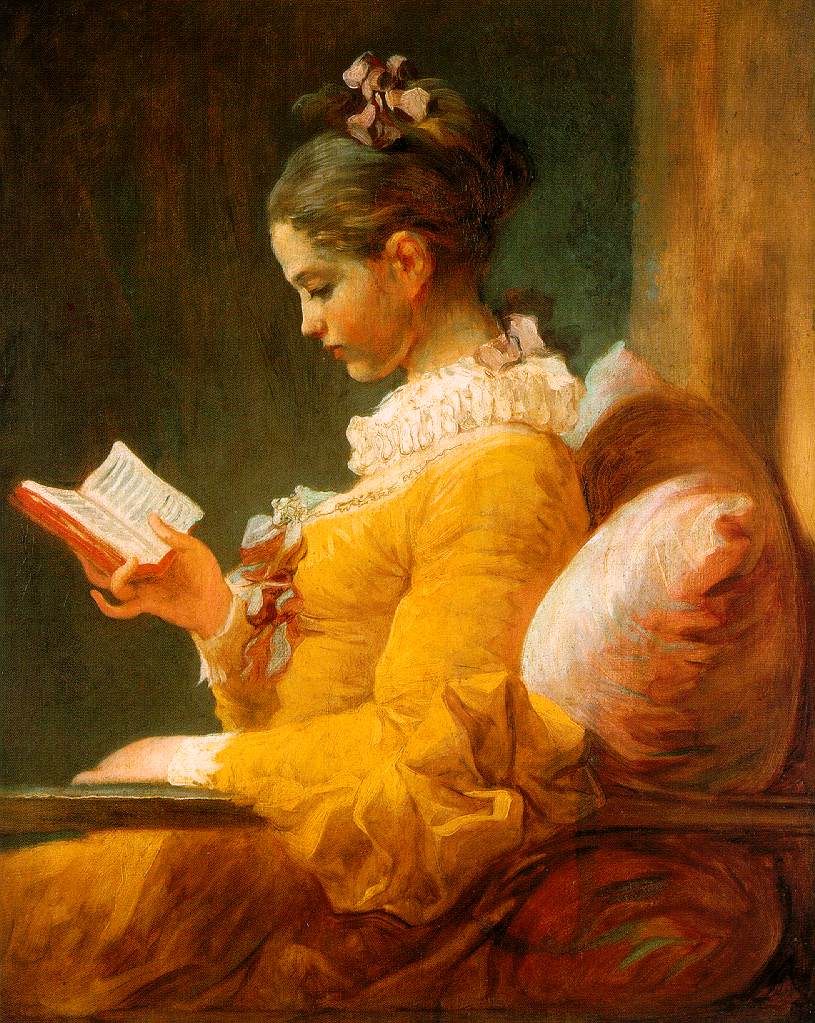 Fragonard’s painting, "The Reader," (figure 9; 1769-72) does
not invest the figure with a specific legible meaning. The painting is
one of fourteen paintings art historians call "Figures de Fantaisie,"
all men and women in half-length portraits of the same dimension, apparently
executed very quickly, and dressed in what were known as Spanish costumes...with
"expressions lively, their eyes turned away...as if they have been
frozen in the middle of an action." (Jean-Pierre Cuzin, 102) Norman
Bryson has explained the effect of these paintings of Fragonard's in terms
that are useful to understanding the absorptive power of novel reading,
especially of the vivid "hallucination" of experiencing Richardson's
characters as though they were real persons.(104) To know a character
in a novel or the woman in this painting as an "ideal presence, half
transmitted by the artwork" requires "for its full existence
the imaginative participation of reader or viewer"(Bryson, 104).
There are several ways "The Reader" teases its viewer into interpretation:
the painting is incomplete (for example in the drawing of the left hand)
but the brush-strokes are richly evocative; the blankness of the background
withholds any context for this figure; and, and finally, the brilliant
foreground lighting of the Reader’s gold and white Spanish costume gives
this pretty young woman an oddly extravagant aura. She seems to be posed
for our gaze, but she looks away. The delicate balance of book, hand and
head as seen in profile, and the ease of her body resting against cushion
and arm rail, communicates the graceful self-completeness of the solitary
reader. Some art historians suppose that "The Reader" is the
portrait of an actual young woman (Curzin, 123-125), "The Reader"
remains enveloped in mystery, as illusive as the thoughts and feelings
of another person's reading. In this painting, reading achieves an allegorical
generality.
Fragonard’s painting, "The Reader," (figure 9; 1769-72) does
not invest the figure with a specific legible meaning. The painting is
one of fourteen paintings art historians call "Figures de Fantaisie,"
all men and women in half-length portraits of the same dimension, apparently
executed very quickly, and dressed in what were known as Spanish costumes...with
"expressions lively, their eyes turned away...as if they have been
frozen in the middle of an action." (Jean-Pierre Cuzin, 102) Norman
Bryson has explained the effect of these paintings of Fragonard's in terms
that are useful to understanding the absorptive power of novel reading,
especially of the vivid "hallucination" of experiencing Richardson's
characters as though they were real persons.(104) To know a character
in a novel or the woman in this painting as an "ideal presence, half
transmitted by the artwork" requires "for its full existence
the imaginative participation of reader or viewer"(Bryson, 104).
There are several ways "The Reader" teases its viewer into interpretation:
the painting is incomplete (for example in the drawing of the left hand)
but the brush-strokes are richly evocative; the blankness of the background
withholds any context for this figure; and, and finally, the brilliant
foreground lighting of the Reader’s gold and white Spanish costume gives
this pretty young woman an oddly extravagant aura. She seems to be posed
for our gaze, but she looks away. The delicate balance of book, hand and
head as seen in profile, and the ease of her body resting against cushion
and arm rail, communicates the graceful self-completeness of the solitary
reader. Some art historians suppose that "The Reader" is the
portrait of an actual young woman (Curzin, 123-125), "The Reader"
remains enveloped in mystery, as illusive as the thoughts and feelings
of another person's reading. In this painting, reading achieves an allegorical
generality.
If Fragonard's painting offers an implicit endorsement of the pleasures
of a young girl's reading, 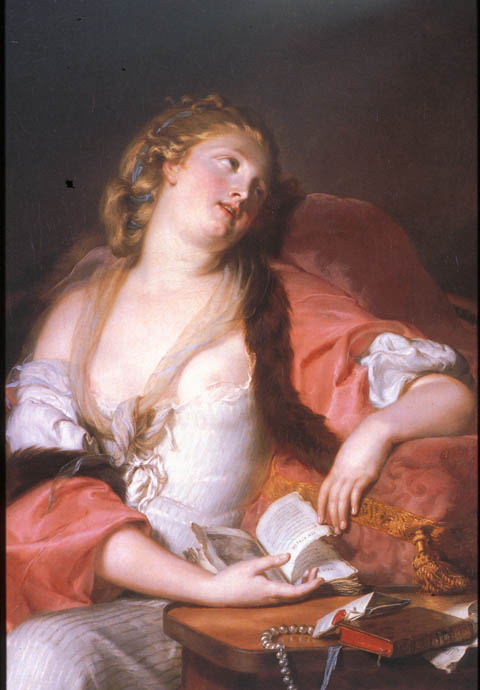 Greuze's "Lady reading Eloise and Abelard" (figure 10; 1758-59)
seeks to make visible the explicitly erotic dangers of novel reading.
In contrast with the self-possession of Fragonard's reader, passion sweeps
through this solitary reader: there is a strong contortion to her position,
her lips are open, her hands languorous. The title of this painting by
Greuze gives the reason for this disorder: "Lady Reading the Letters
of Helouise and Abelard." The tokens on her table—a billet-doux,
a string of black pearls, a sheet of music, and a book entitled "The
Art of Love"—are the details that allow the viewer of the painting
to surmise that this reader is involved in an affair of her own. The lighting
and contiguity of book, dress and bosom invite the viewer to detect a
causal relationship: it is precisely this kind of reading that
leads to illicit affairs, it is this novel that has transported
this lady into a state of distracted arousal. But the didacticism of this
image is fraught with unintended consequences. By linking the animated
white leaves of the book to the white morning dress that is slipping off
the partially exposed breasts of this aroused reader, by inviting us to
survey the erotic effects of novel reading upon the body of this woman,
this painting becomes as lush and explicit and arousing as the novel reading
it intends to warn us against. The resulting confusion of erotic means
and ends is one Greuze's painting will share with Richardson's novels.
(Warner, Licensing Entertainment, 212-224)
Greuze's "Lady reading Eloise and Abelard" (figure 10; 1758-59)
seeks to make visible the explicitly erotic dangers of novel reading.
In contrast with the self-possession of Fragonard's reader, passion sweeps
through this solitary reader: there is a strong contortion to her position,
her lips are open, her hands languorous. The title of this painting by
Greuze gives the reason for this disorder: "Lady Reading the Letters
of Helouise and Abelard." The tokens on her table—a billet-doux,
a string of black pearls, a sheet of music, and a book entitled "The
Art of Love"—are the details that allow the viewer of the painting
to surmise that this reader is involved in an affair of her own. The lighting
and contiguity of book, dress and bosom invite the viewer to detect a
causal relationship: it is precisely this kind of reading that
leads to illicit affairs, it is this novel that has transported
this lady into a state of distracted arousal. But the didacticism of this
image is fraught with unintended consequences. By linking the animated
white leaves of the book to the white morning dress that is slipping off
the partially exposed breasts of this aroused reader, by inviting us to
survey the erotic effects of novel reading upon the body of this woman,
this painting becomes as lush and explicit and arousing as the novel reading
it intends to warn us against. The resulting confusion of erotic means
and ends is one Greuze's painting will share with Richardson's novels.
(Warner, Licensing Entertainment, 212-224)
William Hogarth embeds a warning against novel reading into a non-seductive,
broadly comic set of images. In Hogarth’s playful pair of erotic prints
from 1736, entitled "Before"(figure 11; 1736) 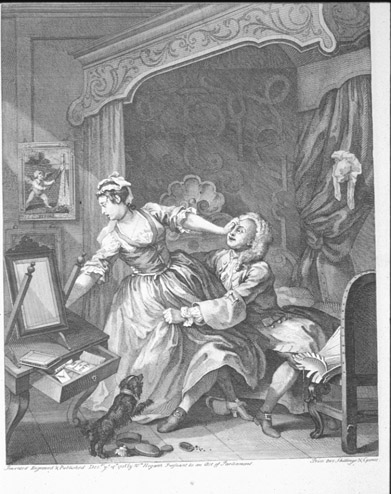 and
"After" (figure 12; 1736), William Hogarth finds a very different
way to encode a warning against novel reading. The heroine’s succumbing
to her admirer suggests that the influence of the volume of "Novels",
as well as the poems of Rochester, have prevailed over the other book
on her night stand, "The Practice of Piety." In this pair of
prints, the abrupt movement from the "before" to "after"
(sex), prevents precisely the sort of absorptive identification Greuze's
painting encourages.
and
"After" (figure 12; 1736), William Hogarth finds a very different
way to encode a warning against novel reading. The heroine’s succumbing
to her admirer suggests that the influence of the volume of "Novels",
as well as the poems of Rochester, have prevailed over the other book
on her night stand, "The Practice of Piety." In this pair of
prints, the abrupt movement from the "before" to "after"
(sex), prevents precisely the sort of absorptive identification Greuze's
painting encourages.
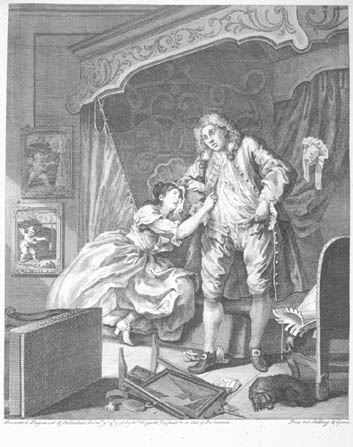 The reader of these two prints is positioned as a bemused observer of
a comic deflation in condition: in "Before," the woman is a
heroic defender of her virtue, but "After" she is a pathetic
petitioner for the man's attentions; and likewise, the man goes from being
the robust lover to a condition of confused, and slightly harassed, sexual
reticence. While Hogarth’s moral rhetoric in this pair obliquely invokes
the warning of the epoch’s anti-novel discourse—that is, ‘purify your
reading if you would guard your virtue’—, his more famous Progress Pieces,
are much closer in their narrative trajectory and entertainment values
of the novels they ostensibly spurn. For most of the 18th century, readers
accepted as a truism the proposition that novel reading did one no real
good, and that other, more serious reading, should attract our reading
energies. For an example of this by then antiquated opinion, one can read
Jane Austen's satirical account of Mr. Collins attempted reading of Fordyce's
sermons after supper on his first night with the Bennet's in Pride
and Prejudice (1812?). In one pair of paintings, John Opie offers
wry social commentary upon this chronic schism in the order of reading.
In "A Moral Homily" (figure 13; date), Opie represents the likely
effects of improving reading here imposed by a solemn dame upon her comely
young auditors—yawns and boredom.
The reader of these two prints is positioned as a bemused observer of
a comic deflation in condition: in "Before," the woman is a
heroic defender of her virtue, but "After" she is a pathetic
petitioner for the man's attentions; and likewise, the man goes from being
the robust lover to a condition of confused, and slightly harassed, sexual
reticence. While Hogarth’s moral rhetoric in this pair obliquely invokes
the warning of the epoch’s anti-novel discourse—that is, ‘purify your
reading if you would guard your virtue’—, his more famous Progress Pieces,
are much closer in their narrative trajectory and entertainment values
of the novels they ostensibly spurn. For most of the 18th century, readers
accepted as a truism the proposition that novel reading did one no real
good, and that other, more serious reading, should attract our reading
energies. For an example of this by then antiquated opinion, one can read
Jane Austen's satirical account of Mr. Collins attempted reading of Fordyce's
sermons after supper on his first night with the Bennet's in Pride
and Prejudice (1812?). In one pair of paintings, John Opie offers
wry social commentary upon this chronic schism in the order of reading.
In "A Moral Homily" (figure 13; date), Opie represents the likely
effects of improving reading here imposed by a solemn dame upon her comely
young auditors—yawns and boredom. 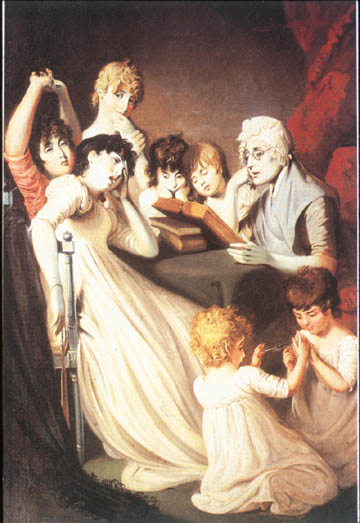 However,
the structure the governess or teacher has imposed—auditors gathered around
one reader with the book—can be adopted to other purposes.
However,
the structure the governess or teacher has imposed—auditors gathered around
one reader with the book—can be adopted to other purposes.
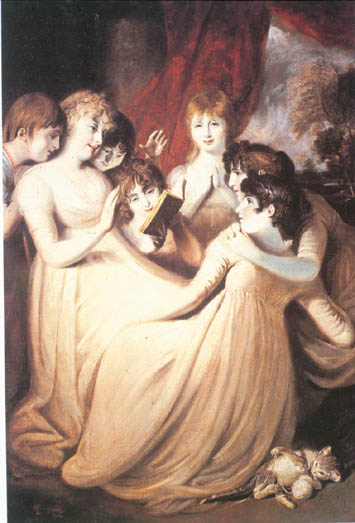 Once
the austere matriarch has left, evidently taking her heavy tomes with
her, the girls can gather into a rapt circle to hear "A Tale of Romance,"(figure
14; date) the title of this painting. Opie's representations of novel
reading and its effects suggest a question for those who want to exploit
the improving potential of books.
Once
the austere matriarch has left, evidently taking her heavy tomes with
her, the girls can gather into a rapt circle to hear "A Tale of Romance,"(figure
14; date) the title of this painting. Opie's representations of novel
reading and its effects suggest a question for those who want to exploit
the improving potential of books.
How is an author to solve the problem posed by adolescent boredom with
conduct discourse and fascination with narratives of love? For a writer
like Samuel Richardson what was required was above all the development
of a hybrid form of writing, one which would use stories of love to attract
young readers to the higher purposes of reading, reading as a spur to
meditation. The connection between books and mediation is illustrated
by the print entitled "Meditation" (figure 15; date)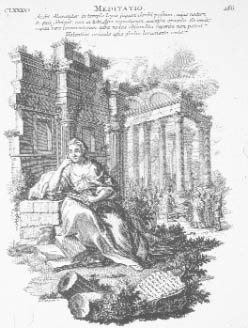 from Ripa’s Iconologia (1709). With a book on her lap, and her
feet on several grand folios, reading has become a prod to deep thought.
In Ripa’s gloss on this iconography, dame Meditation’s "holding up
her head with her hand, denotes the gravity of her thoughts."(Paulowicz,
50)
from Ripa’s Iconologia (1709). With a book on her lap, and her
feet on several grand folios, reading has become a prod to deep thought.
In Ripa’s gloss on this iconography, dame Meditation’s "holding up
her head with her hand, denotes the gravity of her thoughts."(Paulowicz,
50)
In this Reynolds portrait,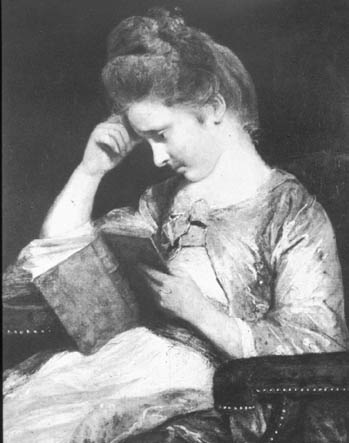 entitled
"Theophilia Palmer Reading Clarissa Harlow"(figure 16; date),
we find the same tight compositional circle of head, arms and book we
have found in other absorbed readers. But here Reynold's use of the iconography
of meditation--the touch of the hand to the forehead--gives visual expression
to Richardson’s program to reconcile novel reading with the weighty
purposes of moral reflection. With this painting, Reynolds represents
the woman reader Richardson intended Clarissa to win: one immune
from erotic appropriation. Thus, Reynolds does not imbue this woman novel
reader with any of the mystery of Fragonard's "Reader" or the
emotionally labile susceptibility of Greuze's reader. Instead, here we
have an ordinary girl, safely ensconced in her sturdy chair, directing
her full attentions to Clarissa Harlowe. But the actual readers
of Richardson's novels found them rife with erotic potential. (footnote:For
the remarkably erotic imagery that develops around the Pamela vogue,
see James Turner, Representations. For accounts of the dangous
effects of reading Richarson's novels see RC, LE.)
entitled
"Theophilia Palmer Reading Clarissa Harlow"(figure 16; date),
we find the same tight compositional circle of head, arms and book we
have found in other absorbed readers. But here Reynold's use of the iconography
of meditation--the touch of the hand to the forehead--gives visual expression
to Richardson’s program to reconcile novel reading with the weighty
purposes of moral reflection. With this painting, Reynolds represents
the woman reader Richardson intended Clarissa to win: one immune
from erotic appropriation. Thus, Reynolds does not imbue this woman novel
reader with any of the mystery of Fragonard's "Reader" or the
emotionally labile susceptibility of Greuze's reader. Instead, here we
have an ordinary girl, safely ensconced in her sturdy chair, directing
her full attentions to Clarissa Harlowe. But the actual readers
of Richardson's novels found them rife with erotic potential. (footnote:For
the remarkably erotic imagery that develops around the Pamela vogue,
see James Turner, Representations. For accounts of the dangous
effects of reading Richarson's novels see RC, LE.)
Why are so many images of readers reading so close to the plane of the
canvas that they threaten to fall right into the viewer's own space? Norman
Bryson's interpretation of the "transformations of rococo space"
during the first half of the 18th century offers an account that links
one of the chief traits of the rococo--the elimination of classical space
established through Renaissance perspective--and the way the subject on
the surface of the rococo makes itself available to the fascinated gaze
of the beholder. Within "rococo space" Bryson finds that "the
erotic body is not a place of meanings and the erotic gaze does not attend
to signification... [instead the painting devotes its painterly resources
to] providing a setting for the spectacle...transported to [a] space that
is as close as possible to that inhabited by the viewer..[that] of the
picture plane [itself]."(Bryson, 91-92) 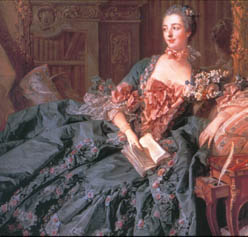 One
can see the erotic potential of this sort of compositional strategy at
work, in a rather sublimated form, in a glamorous portrait by Francois
Boucher, of his celebrated patron "Mme. Pompador," the mistress
to Louis the XVth (figure 17; date). This portrait catches its subject
in a momentary pause in the elegant leisure activity of what is most likely
novel reading. Several factors conspire to compose a shimmering surface
that invites the spectator's gaze to wander: the oblique gaze of Mme.
Pompador releases our eyes from her face; instead the viewer's eye is
free to wander over the artful arrangement of her arms and hands, over
the richly detailed silk brocade of her dress, to the animated leaves
of the book that lies at the center of this composition. Here is painting
that addresses its beholder outside of any informing moral purpose, looking
that is in danger of becoming its own pleasurable end. The anti-rococo
reaction, most evident in the morally programmatic paintings of Greuze,
resonates with the anti-novel discourse deployed by Richardson in his
morally programmatic narratives. For critics of early modern novel reading
were not just concerned about mimicry of a novel’s action; they were also
alarmed about the perverse displacement by which the reader, through the
repetitive effects of absorptive reading for pleasure, conducted in freedom
and solitude, (in other words in the sort of autonomous erotic reverie
the rococo encourages) might become a compulsively reading body. In a
painting entitled "Reclining Nude" (figure 18; 1751; Cologne,
Wallraf-Richartz Museum)
One
can see the erotic potential of this sort of compositional strategy at
work, in a rather sublimated form, in a glamorous portrait by Francois
Boucher, of his celebrated patron "Mme. Pompador," the mistress
to Louis the XVth (figure 17; date). This portrait catches its subject
in a momentary pause in the elegant leisure activity of what is most likely
novel reading. Several factors conspire to compose a shimmering surface
that invites the spectator's gaze to wander: the oblique gaze of Mme.
Pompador releases our eyes from her face; instead the viewer's eye is
free to wander over the artful arrangement of her arms and hands, over
the richly detailed silk brocade of her dress, to the animated leaves
of the book that lies at the center of this composition. Here is painting
that addresses its beholder outside of any informing moral purpose, looking
that is in danger of becoming its own pleasurable end. The anti-rococo
reaction, most evident in the morally programmatic paintings of Greuze,
resonates with the anti-novel discourse deployed by Richardson in his
morally programmatic narratives. For critics of early modern novel reading
were not just concerned about mimicry of a novel’s action; they were also
alarmed about the perverse displacement by which the reader, through the
repetitive effects of absorptive reading for pleasure, conducted in freedom
and solitude, (in other words in the sort of autonomous erotic reverie
the rococo encourages) might become a compulsively reading body. In a
painting entitled "Reclining Nude" (figure 18; 1751; Cologne,
Wallraf-Richartz Museum)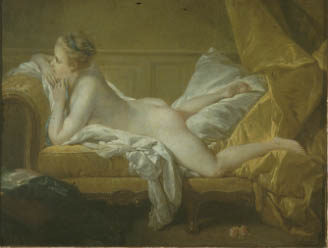 ,
Boucher uses another of Louis XV's mistresses, Louise O'Murphy
as a model. Here, the open book to the left of the nude woman reclining
on the couch suggests that the equivocal potential of reading novels for
pleasure arises in part from a shift in location: one may read these books
in the intimate undress of the boudoir.
,
Boucher uses another of Louis XV's mistresses, Louise O'Murphy
as a model. Here, the open book to the left of the nude woman reclining
on the couch suggests that the equivocal potential of reading novels for
pleasure arises in part from a shift in location: one may read these books
in the intimate undress of the boudoir.
The novel in this setting functions as a stimulant, like tea in the samovar,
which has replaced the novel in this rendering of the same model in the
same pose 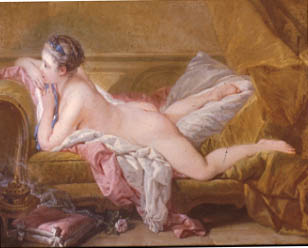 in
a painting of the same title (figure 19; 1752; Munich, Alte Pinokotk ).
in
a painting of the same title (figure 19; 1752; Munich, Alte Pinokotk ).
With a small difference in position, and woth a dark haired model, the
painting becomes more explicitly salacious, and well on the way to the
pornographic image. (figure 20; 1745). 
1748, the year of the publication of the third and final installment
of Clarissa, is the same year as John Cleland’s anonymous publication
of "The Memoirs of a Woman of Pleasure", better known to us
by the title, "Fanny Hill." The erotic use of novels becomes
quite explicit in this Pierre Antoine Baudourin’s print of 1770, entitled
"Midi" (figure 21). 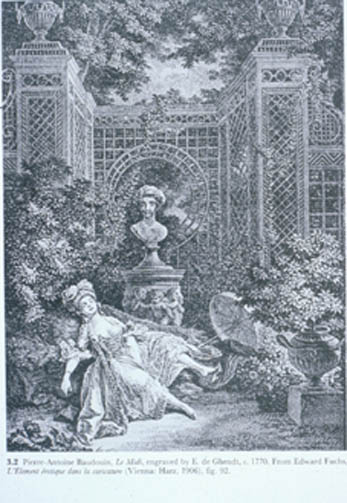 This
image suggests that the head or heart were not the only body parts that
might be stimulated by reading. In his analysis of this print, Jean Marie
Goulemot notes what invites the viewer to enjoy this spectacle of this
aroused young lady: the secure enclosure of a stage-like garden setting,
the presence of a voyeur in the form of a statue, and the young female
body posed to maximize our view of her. The print invites us to note the
crucial details: a small book has dropped from her right hand; her left
hand had disappeared into her dress. In this print the outcome dreaded
within the anti novel discourse, the reader aroused to the point of orgasm,
becomes a positive program: solitary reading for entertainment is a preparative
to masturbation. The reading body has become a pleasure machine.
This
image suggests that the head or heart were not the only body parts that
might be stimulated by reading. In his analysis of this print, Jean Marie
Goulemot notes what invites the viewer to enjoy this spectacle of this
aroused young lady: the secure enclosure of a stage-like garden setting,
the presence of a voyeur in the form of a statue, and the young female
body posed to maximize our view of her. The print invites us to note the
crucial details: a small book has dropped from her right hand; her left
hand had disappeared into her dress. In this print the outcome dreaded
within the anti novel discourse, the reader aroused to the point of orgasm,
becomes a positive program: solitary reading for entertainment is a preparative
to masturbation. The reading body has become a pleasure machine.
Given the range of these images of readers reading, one might well ask "Is reading to serve education, provide entertainment, promote moral improvement, or turn us on?" My study of British print media culture suggests the answer should be, "All of the above." The diverse representation of novel reading in the painting and prints of the 18th century, and the polymorphous uses of painting (for instruction, pleasure, etc.) suggest the struggle going on in the culture at large. Over the arc of the period, educational and moral projects to improve reading collide with market driven efforts to popularize reading in such a way as to expand and deepen the repertoire of reading practices. Thus between 1684 and 1730, Behn, Manley and Haywood wrote short, erotic, plot-centered novels that were accepted as the fashionable new thing in reading. However, the avid reading of these novels, especially by youth, drew a strong critique from those who wished to reserve reading for valuable, elevating, educational practices. In response, novelists like Manley and Haywood blended the anti-novel discourse into their own novels as a way to make novel reading more deliciously transgressive, as well as to protect their own novels from censure. Reformers of the novel –from Defoe and Aubin to Richardson and Fielding—sought to rewrite reading by offering their novels as substitutes and antidotes to the novels of amorous intrigue. But while they sought to purify their narratives of novelistic erotics, they could only guarantee the popularity of their books by incorporating the plot formulas and character types perfected by their antagonists. By my account, the Pamela media event—the outpouring of criticism, sequels, and revisions that followed the 1740 publication of Pamela—marks a turning point in the debate about the pleasures and dangers of novel reading. By winning a large and admiring readership, and by attracting sustained acts of criticism, Pamela changed the terms of the anti- and pro-novel discourse. Now it is not a question of whether one should read novels, but of what kind of novels will be beneficial or dangerous to readers. Richardson’s project finds itself overcome by this irony: while he seeks to purge print media culture of corrupting novel reading, he can only do so by inventing new hybrids, like Pamela. While Pamela is supposed to be a non-novel which will end novel reading, in fact, of course, it expands the practices of reading, and the possibilities for novel writing. In order to enter the psychosexual life of its protagonists, the readers of Pamela practice hyper-absorptive reading which achieves new levels of emotional intensity and identification. This provides the pretext for new forms of erotic writing, like John Cleland’s Memoirs of a Woman of Pleasure, which stars a heroine-prostitute who has an odd combination of innocence and experience. In later decades Richardson’s Clarissa and Rousseau’s Richardsonian novel La Nouvelle Heloise invite rewriting as Laclos’s Les Liasions Dangereuses and Sade’s Justine. Efforts at moral and generic purification breed new hybids and mediators.
I can summarize the literary historical implications of this narrative, and come back to issue of the novel's "rise," in this way: when the market’s modernization of reading for entertainment stimulates an ethically motivated anti-modern critique, we get a hybrid of amorous novels and conduct discourse, which subsequent English literary historians dub "the first modern novels in English." Richardson and Fielding are usually given credit for this invention. Why? Because their novels include something central to all subsequent novels: a reader’s guide on how to use print media. Thus, at least since Fielding’s model Don Quixote, the novel warns readers of the dangers of mindless emulation; the novel teaches the reader the difference between fiction and reality; and the novel interrupts the atavistic absorption of the reader by promoting an ethical reflection upon the self. In this way the early modern struggle around the proper uses of reading sediments itself as thematic concerns and narrative processes within the elevated novel. But such a project of purification can not prevent, it may in fact incite, the development of new hybrids. By 1764, Horace Walpole pronounces himself bored with the limitations of the modern novel’s reading protocols and its version of reality. So Walpole offers his "gothic tale," The Castle of Ortranto, as a self-consciously concocted blend of ancient and modern romance.
These comments suggest some of the ways I have sought, in my book Licensing Entertainment, to challenge the distinctions, separations and efforts at purification evident in the canonical account of the novel’s acquisition of modern legitimacy, Ian Watt’s The Rise of the Novel. By aligning the formal traits of Richardson’s writing with reality, Watt countersigns the rough drafts for the ‘rise of the novel’ thesis Richardson and Fielding penned during and after the Pamela media event. By making a single novel an object and occasion for sustained critical writing, the Pamela media event defined task of much future novel criticism: selected novels are declared to be more than a vehicle of leisure entertainment. They come to be objectified as "the" novel and valued as a new literary genre. In the process, the promiscuous and unclassified mass of romances and novels that remain are cast into limbo as "non-novels." In order to secure the distinction between "the" novel and its others, criticism acquires the gate-keeping function evident in a range of practices developed over the 60 years following the Pamela media event: the emergence of journals reviewing novels (Monthly Review, 1749-; and Critical Review,1756-); literary histories of the novel; the collection of novels into anthologies and multi-volume sets; and the inclusion of novels in pedagogical projects, from those directed at young girls to those of Scottish university professors.(Court, 17-38) Of course, my book and this talk don’t escape that academic discursive system for defining novels. The institution of criticism and the pedagogical practice of English professors are shaped to teach informed reading, that is, reading purged of mimicry. Pedagogy becomes the cure prescribed for market based media. Of course, in the process, we may be replacing compulsive novel reading with our own repetitive and obsessional practice: "close" reading. Our institutional practices of teaching literature, and cultural narratives like "the rise of the novel," are deeply implicated in an ongoing effort, which began with the anti-print media discourse of the eighteenth century, to protect readers from market culture. In short, we are the late-modern offspring of early modern media policy.